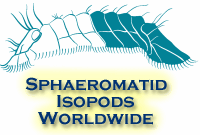| Abstract |
From January 1993 to September 1995, Cyathura carinata was a target species of a monitoring programme carried in the Mondego Estuary (Portugal). Being one of the key species of the intertidal mud flats, this isopod was found to be most abundant in a eutrophic area, where seasonal macroalgal blooms usually occur. Its density decreased towards downstream areas, where some Zostera noltii beds exist. At the Mondego Estuary, the present work stated that C. carinata: (a) had a 2-year life span, even though, 80–90% of the individuals died when 1 year old, revealing a strong post-reproduction mortality; (b) produced a single cohort per year; (c) showed continuous growth (with lower rates during winter); (d) evidenced protogynous hermaphroditism and (e) presented a high growth production and a low turnover ratio. A latitudinal gradient reflected in the life features of C. carinata was described. Except for the life span and the frequency of reproduction, which are generally valid for all populations, C. carinata from the Mondego Estuary fitted the characteristics of other populations from the south of Europe.
The effects of macroalgal blooms were assessed. Cyathura carinata seemed to temporarily benefit from the presence of macroalgae, due to higher energy resources and more efficient protection against predators. In a long term, algal blooms had negative consequences. It was particularly evident on the recruitment success, which had repercussions in population abundance, and on the secondary production. Therefore, repeated events of algal blooms embracing the distribution areas of C. carinata represent a threat to this species in eutrophic estuaries. |

















